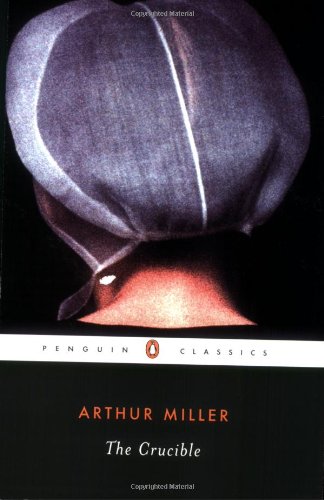All Nonfiction
- Bullying
- Books
- Academic
- Author Interviews
- Celebrity interviews
- College Articles
- College Essays
- Educator of the Year
- Heroes
- Interviews
- Memoir
- Personal Experience
- Sports
- Travel & Culture
All Opinions
- Bullying
- Current Events / Politics
- Discrimination
- Drugs / Alcohol / Smoking
- Entertainment / Celebrities
- Environment
- Love / Relationships
- Movies / Music / TV
- Pop Culture / Trends
- School / College
- Social Issues / Civics
- Spirituality / Religion
- Sports / Hobbies
All Hot Topics
- Bullying
- Community Service
- Environment
- Health
- Letters to the Editor
- Pride & Prejudice
- What Matters
- Back
Summer Guide
- Program Links
- Program Reviews
- Back
College Guide
- College Links
- College Reviews
- College Essays
- College Articles
- Back
The Crucible by Arthur Miller
There are two types of people that have always been in the world: those who cover for injustice and those who fight injustice. There is not much known about the Salem Witch Trials regarding innocence or guilt, so the event becomes a fantasy plaything for any writer to come up with their own choice. Arthur Miller tells his opinion of the Trials in the Crucible.
Set in Salem, Miller uses various different locations to explore different conflicts. These places include Mr. Parris’s house, Mr. Proctor’s house, the high court, and consciences of each character. The book goes into the characters of Mr. Proctor, Abigail Williams, Elizabeth Proctor, Rev. John Hale and Governor Danforth, as well as a few others. Miller shows in each of these characters their extents and most particularly their trust. Rev. Hale is shown his extent on how far he is willing to go through with the trials when Mr. Proctor enters. Hale is the character who much represents the audience as he seems to waver from one person to another as truth is revealed, trying to understand the situation.
Betty Parris is found sick or possessed after dancing in the woods, and she does not wake up. Then another girl is mysteriously ill. After that Mr. Parris, the pastor, calls for outside help thinking the worst: that the girls were with the devil. Grabbing hold of the situation, Abigail Williams, who was also dancing, agrees to the thought that devil was there and begins to accuse. Although not every person believes her that the devil would take so many reasonable girls all at once. One of these people is Mr. John Proctor. He is a sensible man who is suspicious of everything, but he is also a sinner. His wife found out his sin, and his previous relationship with Abigail, but did little in response to their sin. Then the trouble begins as people in power begin to believe that the masses of girls are in contract with the Devil. Day in and day out the girls are either ‘confessing’ to their sin or being hanged. This continues until Mr. Proctor and his wife are accused.
Miller’s intent in writing this book was not to give historical accuracy, but to have the reader “discover the...nature of the strangest and most awful chapters in human history” (Miller,345). Miller had achieved this goal. He shows true brutality and greed in the judged and judges of the Trials. Even in his writing style Miller tells the reader that a character is unjust or plain evil. He shows it in the dialogue of the character. For example John Proctor is a good, simple man; and Miller writes his lines and staging as a good simple man. Miller writes in one scene that Mr. Proctor faces Judge Danforth as “He is speaking reasonably, restraining all his fears, his anger and his anxiety” (Miller, 419) He expresses clearly how he wants the reader to feel about certain characters. He invests a lot of time into making you distrust and dislike Abigail or pity and respect Elizabeth Proctor. In addition to the deep writing style, Miller develops his main character, Mr. Proctor, all the way through to the point of the reader agreeing with Mrs. Proctor-- and indirectly Miller, at the end of the book. The Crucible was so well written and explained through Miller’s manner of description that I have not found a solid fault with it.Every one seems to get Miller’s theme across that “the individuals must be purged separately so that the community as a whole may be preserved”(Bonnet) of the Puritan community and the justice of it. In contrast to The Death of a Salesman, The Crucible is written better and formed better. Still Miller’s tales contain the same attribute that makes a reader draw themselves into their conscience and think about life.
Although I cannot say that I thoroughly enjoyed The Crucible for its pessimistic plot, I did enjoy Miller’s style of portraying a good character and bad character. I admire Miller for his bravery on approaching a topic of the trials with an opinion that states it as an evil and tries to proof it through fiction. The Crucible was a bit morbid for my usual reading taste, for its death and realistic faults in the characters; some people might find an attribute that they would enjoy. Recommend that no one under thirteen years old read this book for its brutality, diabolical characters and relation to the trials.
Work Cited
1
Miller, Arthur. Arthur Miller: a Collection of Plays1944-1961. New York, New York: The Library of America, 2006
2.
Bonnet, Jean-Marie. "Society vs. The Individual in Arthur Miller's The Crucible." DISCovering Authors. Detroit: Gale, 2003. Student Resources in Context. Web. 15 Jan. 2013.
Similar Articles
JOIN THE DISCUSSION
This article has 0 comments.

